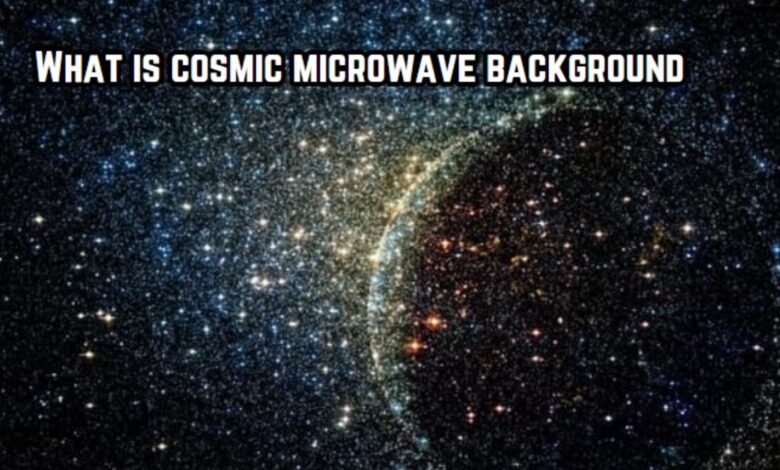What is cosmic microwave background?
Discover what the cosmic microwave background reveals about the universe's formation, the Big Bang theory, and the structure of galaxies.

Heat that remains after Big Bang, event that created our universe is known as Cosmic Microwave Background (CMB). Universe rapidly expanded and cooled at beginning. CMB is remnant heat or radiation from Big Bang.
We can’t see CMB with our eyes because it is very cold—only 2.725 degrees above absolute zero, which is -459.67 degrees Fahrenheit or -273.15 degrees Celsius. This cold temperature means CMB radiation is in microwave range, which is invisible to us.
CMB is everywhere in the universe. It fills all of space evenly. In old days, before cable TV, people could actually see CMB on their TV screens. When they switched to channel with no signal, they would see static and some of that static was from CMB. This static was tiny glimpse of Big Bang’s leftover heat that fills universe.
Formation of Cosmic Microwave Background
Cosmic Microwave Background (CMB) formed long time ago, shortly after universe began. Universe started with Big Bang about 13.8 billion years ago. CMB comes from about 400,000 years after Big Bang.
The universe began at a relatively small size and very high temperature, approximately 273 million degrees above absolute zero. Atoms could not hold together due of extreme heat. Rather, they disintegrated into smaller constituents such as protons and electrons. Photons (which are light particles) were abundant in universe and kept bouncing off these electrons. This caused light to travel more slowly in straight line, similar to how light travels more slowly in dense fog.
The universe cooled down sufficiently for hydrogen atoms to develop after roughly 380,000 years. Photons could move straight ahead and bounce less after hydrogen was produced. Since photons last scattered off particles at this time, it is referred to as the “surface of last scattering”. Universe had grown beyond this limit to point where photons could move freely.
We can still observe light from that era, some 380,000 years after the Big Bang, when we look at the CMB today. For billions of years, light has been traveling across the universe. CMB provides us with an image of the early cosmos, capturing its appearance shortly after it became transparent enough to allow light to flow freely through it.
Discovery of Cosmic Microwave Background
American cosmologist Ralph Alpher predicted existence of Cosmic Microwave Background (CMB) in 1948 while working with Robert Herman and George Gamow. They were studying how elements formed in universe after Big Bang known as Big Bang nucleosynthesis. Their research predicted that there should be leftover radiation from Big Bang which is CMB.
Nevertheless, CMB was unintentionally found in 1965. At Bell Telephone Laboratories, two researchers were working on radio receivers: Arno Penzias and Robert Wilson. Unbeknownst to them, their equipment was making odd noise. This sound was consistent and appeared to originate from every direction in sky.
Robert Dicke led a Princeton University team that was aggressively looking for CMB at the same time. Dicke’s team discovered they had been searching for CMB when they learned about the noise that Penzias and Wilson had detected.
The results were reported in the Astrophysical Journal in 1965 by both parties. Penzias & Wilson reported noise they had seen & Dicke’s group clarified its meaning as post-Big Bang radiation. Significant advancement in our knowledge of early cosmos was this discovery.
Penzias and Wilson won 1978 Physics Nobel Prize in recognition of their contributions. Their unintentional discovery supported Big Bang theory by confirming significant cosmic origins prediction.
- Zoo Breeds Record Number of Condor Chicks for Release
- The Magnetic Force That Shapes Our Galaxy
- Casimir Effect
Insights from Cosmic Microwave Background: What Does It Tell Us?
Because it provides important insights into development of early cosmos, astronomers find great value in Cosmic Microwave Background (CMB). CMB has fairly constant temperature, with very slight variations that can be picked up by sensitive telescopes. NASA states, “By studying these fluctuations, cosmologists can learn about origin of galaxies and large-scale structures of galaxies and measure basic parameters of Big Bang theory.”
First full-sky map of the CMB came from NASA’s Cosmic Background Explorer (COBE) mission, launched in 1989 and concluded in 1993. This map, often referred to as “baby picture” of universe, confirmed predictions of Big Bang theory and revealed cosmic structures previously unseen. COBE mission’s contribution earned scientists John Mather and George Smoot Nobel Prize in Physics in 2006.
In 2003, Wilkinson Microwave Anisotropy Probe (WMAP) provided more detailed map. This data pegged universe’s age at approximately 13.7 billion years (later refined to 13.8 billion years) and revealed that oldest stars began shining about 200 million years after Big Bang, earlier than initially predicted. WMAP also highlighted an asymmetry in average temperatures between the sky’s hemispheres and a larger-than-expected “cold spot.” The WMAP team received the 2018 Breakthrough Prize in Fundamental Physics for their groundbreaking work.
The European Space Agency’s Planck space telescope released its data in 2013, offering the highest precision image of the CMB to date. Planck’s measurements not only revealed that fluctuations at large angular scales did not meet predictions, but they also corroborated WMAP’s conclusions about asymmetry and cold spot. Further proof of presence of dark matter and dark energy, which are assumed to be driving forces behind universe’s accelerating expansion, was supplied by Planck’s final data release in 2018.
Additional research has focused on the CMB’s polarization types, including E-modes and B-modes. The Degree Angular Scale Interferometer first identified E-modes in 2002, while B-modes, potentially from gravitational lensing or waves, were observed by the South Pole Telescope in 2013 and LIGO in 2016. Although the BICEP2 instrument claimed to detect gravitational wave B-modes in 2014, subsequent observations attributed these signals to cosmic dust.
As of mid-2018, scientists continue searching for evidence of a rapid expansion of the universe shortly after Big Bang. This period, which has been called inflation, may be identifiable in CMB due to particular kind of polarization. A 2018 study hypothesized that cosmic observations would be tainted by feeble illumination from nanodiamonds; nonetheless, taking this interference into account could improve future searches for elusive inflation signal.



